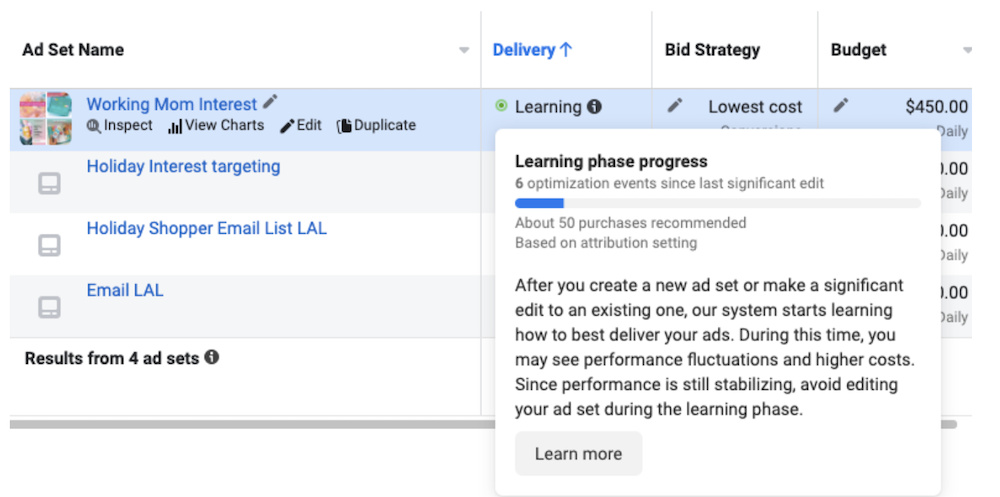How To Scale Ad Spend Quickly (Without Spiking Costs)
Scaling effectively is one of the hardest things to do with your Facebook ads. As a growth marketing agency, one of the problems potential partners come to us most often with is that they’ve gained some sort of traction with their Facebook ads, but don’t know how to efficiently ramp up spend.
To someone not well versed in Facebook advertising, this seems like an easy solution. You’ve got campaigns that are working, so just jack up your daily budgets and start counting your profits! Makes sense right?
If only it were that easy….
Anyone who has experience running Facebook ads knows just how fragile account performance can be. A number of different factors can take your performance for a roller coaster ride, and changing ad spend is one of the largest ones. Growth Marketers are on a seemingly endless quest for stability and predictable results. While that quest will likely never be completed, being mindful of how we adjust our spending on Facebook and our other ad channels will get us one step closer to the promised land of steady results.
Before you can begin increasing your spend on Facebook you need to answer an important question.
Is my ad account ready to start scaling?
One thing we really stress here at Tuff when looking at budgets for our social ads channels is that adding additional budget at an underperforming channel or campaign won’t help your results. There are many problems in life that can be solved by throwing money at them, but poor advertising results isn’t one of them.
There are three stages to running campaigns on Facebook when you’re looking to achieve success at scale:
- Traction
- Scale
- Profit
To sum these steps up, traction is where you put in the work to achieve consistent profitable results, scale is where you increase budgets steadily while still maintaining profitability, and profit is where you swim in your money Scrooge McDuck style.
You’ve got to walk before you can run. The traction phase is where you define what profitability looks like from an account results standpoint. This benchmark will vary greatly depending on your business model. It could be a specific cost per lead, ROAS number or cost per new customer. Whatever it is, you need to understand this tipping point before considering scaling up your budget. This should really be figured out before running ads at all, but that’s for another blog post.
Once you’ve defined your profitability metrics, you’ve got to go out and hit them. Go test audiences, ad creative, and copy combinations until you’ve determined the targeting and messaging needed to hit your profitability metrics.
Before you start scaling, you’ll want to be sure you’re hitting these numbers with some consistency. With how volatile Facebook advertising can be, it’s very likely that you can hit these goals one day, and not even come close the next. You’ll want to see results above your profitability threshold for a significant amount of time before you begin scaling. The amount of time will be different depending on what budget level you start at, but a good rule of thumb is 2-3 weeks of hitting KPIs before increasing your budget.
So now that we’ve got traction, it’s time to look at increasing our budgets, which is the whole reason you’re reading this article. As I mentioned earlier, scaling up too quickly can shock the Facebook algorithm and tank your results, so we always look to scale methodically to avoid that. There are two methods of scaling that we use, which we refer to as vertical scaling and horizontal scaling. We use a combination of these to increase overall budget. Let’s get into what they are.
Scaling vertically
Vertical scaling is the easiest way to increase your ad spend on Facebook. When you scale vertically you’re taking your existing campaign structure and increasing the daily budgets for those campaigns or ad sets. In reality, this is just fancy marketing speak for taking your budget and making it larger, but there is some nuance involved.
It is possible to kick your ad sets back into the “Learning Phase” if you increase your budgets too quickly. An ad set being in the learning phase is an indicator that the algorithm is still working to stabilize your results. While in this state you can expect more volatility and higher than normal costs per action. An ad set leaves the learning phase after about 50 conversion events, at which point performance stabilizes a bit.
Needless to say we want to get out of the learning phase as quickly as possible and stay out of it.
“Large edits” to a campaign or ad sets will move ad sets back into the learning phase, with large increases to budget being one of those possible edits. Specifically, more than a 20% increase in spend to a campaign or ad set will be enough to get sent back to learning phase time out.
All of this is to say keep your daily spend increases to 19% or less of your budget if your ad sets are out of the learning phase. If your ad sets aren’t out of learning just yet, it’s probably a good idea to wait for that to happen before increasing spend.
Scaling horizontally
There is always going to be a point when scaling your existing structure starts to yield diminishing returns. As much as we’d like to scale effective campaigns and ad sets to infinity, there comes a point where you’ve maxed out the amount of spend you can pump into a campaign structure before you have to expand outward to find new efficiencies.
Horizontal scaling is where you look for opportunities outside of your existing structure, usually in the form of new audiences, to spend budget. Audience testing is a huge part of being successful with Facebook advertising and chances are if you’ve made it to the point where you are scaling up your budget, you’ve done your fair share of audience testing already (remember finding traction?)
You’re definitely going to want to find these avenues of potential scale before you need to, so as you’re scaling vertically, it’s always a good idea to test new audiences to see if you can gain traction outside of your existing structure.
When introducing new ad sets, it’s generally best to set the daily budget equal or lower than what your other campaigns/ad sets are at. The last thing you want to do is introduce a new audience at a really high daily budget only to see no traction and burn through a significant amount of ad spend without much return.
Once you see traction from a new audience, you can apply the vertical scaling principals I outlined earlier in the article, rinse and repeat.
Conclusion
Facebook loves consistency when it comes to running an ad account. Want to make a big change to an existing campaign? You’re usually going to get punished in the form of higher costs for a period of time. When scaling up your spend, make sure to stay below that 20% per day threshold to avoid having your ad sets get kicked back into the Learning Phase. Seeing rising costs as you’re scaling your existing structure? It’s probably time to look to scale horizontally with some new audiences.
Want to learn more about how we help our partners achieve results at scale? Set up a call with our team to discuss how we can apply our growth marketing expertise to your business! We’d love to hear from you!

Hi there! I’m Ethan, a Growth Marketer based in Steamboat Springs, Colorado. I have four years of digital agency experience under my belt creating and executing acquisition strategies for a number of different verticals across multiple channels. When I’m not at my desk, you can find me skiing, mountain biking, or chasing my dog around in the mountains.






